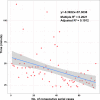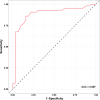Learning Curve Analysis of Microvascular Hepatic Artery Anastomosis for Pediatric Living Donor Liver Transplantation: Initial Experience at A Single Institution
- PMID: 35784920
- PMCID: PMC9247290
- DOI: 10.3389/fsurg.2022.913472
Learning Curve Analysis of Microvascular Hepatic Artery Anastomosis for Pediatric Living Donor Liver Transplantation: Initial Experience at A Single Institution
Abstract
Background: The incidence of hepatic artery thrombosis in pediatric living donor liver transplantation (LDLT) is significantly higher than that in adults, and is closely related to the surgeon's experience with hepatic artery anastomosis. However, there are few studies on the learning curve of hepatic artery anastomosis among surgeons.
Methods: We collected data related to 75 patients who underwent pediatric LDLT and hepatic artery anastomosis independently by the same surgeon. Cumulative sum method (CUSUM) was used to analyse the duration of hepatic artery anastomosis and determine the cut-off value. Patients were divided into two phases according to CUSUM. We analysed the intraoperative and postoperative data and survival outcomes of the included patients.
Results: Total anastomosis duration decreased with an increased number of completed procedures, and the average duration was 42.4 ± 2.20 min. A cut-off value and two phases were identified: 1-43 cases and 44-75 cases. Intraoperative blood loss was significantly lower in phase 2 than in phase 1. The immediate functional changes of total bilirubin (TBIL) and direct bilirubin (DBIL) were significantly also lower in phase 2 than in phase 1. Other functional outcomes, postoperative complications, and the long-term survival rate were not significantly different between the two phases.
Conclusions: Technical competence in pediatric LDLT hepatic artery anastomosis may be achieved after completing 43 cases. It is a safe procedure with a surgical loupe that can be systematized and adopted by pediatric surgeons with sufficient experience via a relatively long learning curve.
Keywords: anastomosis; hepatic artery; learning curve; living donor; pediatric liver transplantation.
Copyright © 2022 Zhou, Dai, Le, Xing, Tan and Zhang.
Conflict of interest statement
The authors declare that the research was conducted in the absence of any commercial or financial relationships that could be construed as a potential conflict of interest.
Figures
Similar articles
-
Microvascular Hepatic Artery Anastomosis in Pediatric Living Donor Liver Transplantation: 73 Consecutive Cases Performed by a Single Surgeon.Plast Reconstr Surg. 2018 Dec;142(6):1609-1619. doi: 10.1097/PRS.0000000000005044. Plast Reconstr Surg. 2018. PMID: 30239502
-
Hepatic artery microvascular anastomosis in pediatric living donor liver transplantation: a review of 35 consecutive cases by a single microvascular surgeon.J Reconstr Microsurg. 2009 Sep;25(7):439-43. doi: 10.1055/s-0029-1223853. Epub 2009 May 19. J Reconstr Microsurg. 2009. PMID: 19455488
-
Demonstrating the Non-inferiority of a Plastic Surgery Microscopic Technique for Hepatic Artery Anastomosis in Pediatric Liver Transplant: A Single-Institution Study.Cureus. 2024 Aug 25;16(8):e67742. doi: 10.7759/cureus.67742. eCollection 2024 Aug. Cureus. 2024. PMID: 39318928 Free PMC article.
-
A Systematic Review and Meta-Analysis: Do We Still Need Microscope Surgery in Hepatic Artery Anastomosis to Decrease the Incidence of Complications in Living Donor Liver Transplantation?Cureus. 2023 Nov 1;15(11):e48112. doi: 10.7759/cureus.48112. eCollection 2023 Nov. Cureus. 2023. PMID: 37920422 Free PMC article. Review.
-
Microscope-Assisted Arterial Anastomosis in Adult Living Donor Liver Transplantation: A Systematic Review and Meta-analysis of Outcomes.J Reconstr Microsurg. 2022 May;38(4):306-312. doi: 10.1055/s-0041-1732349. Epub 2021 Aug 24. J Reconstr Microsurg. 2022. PMID: 34428807
References
LinkOut - more resources
Full Text Sources





